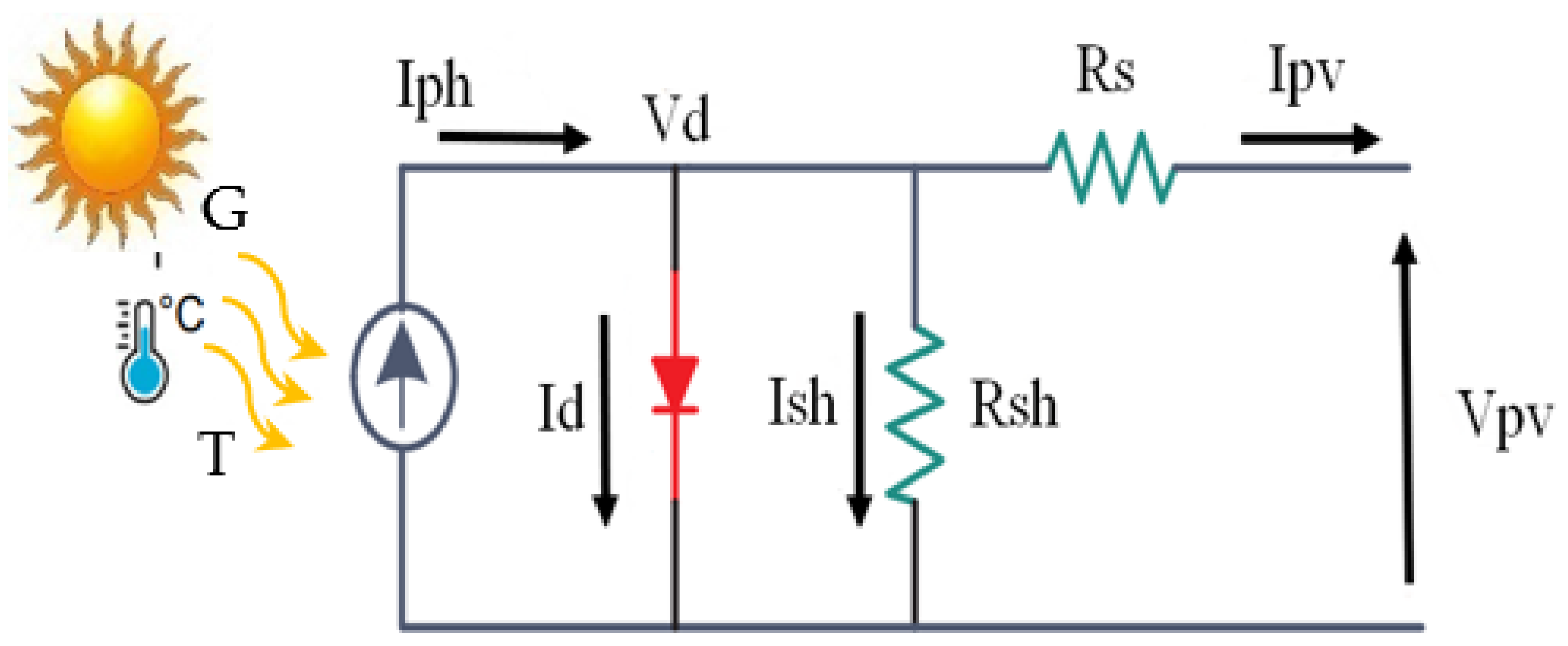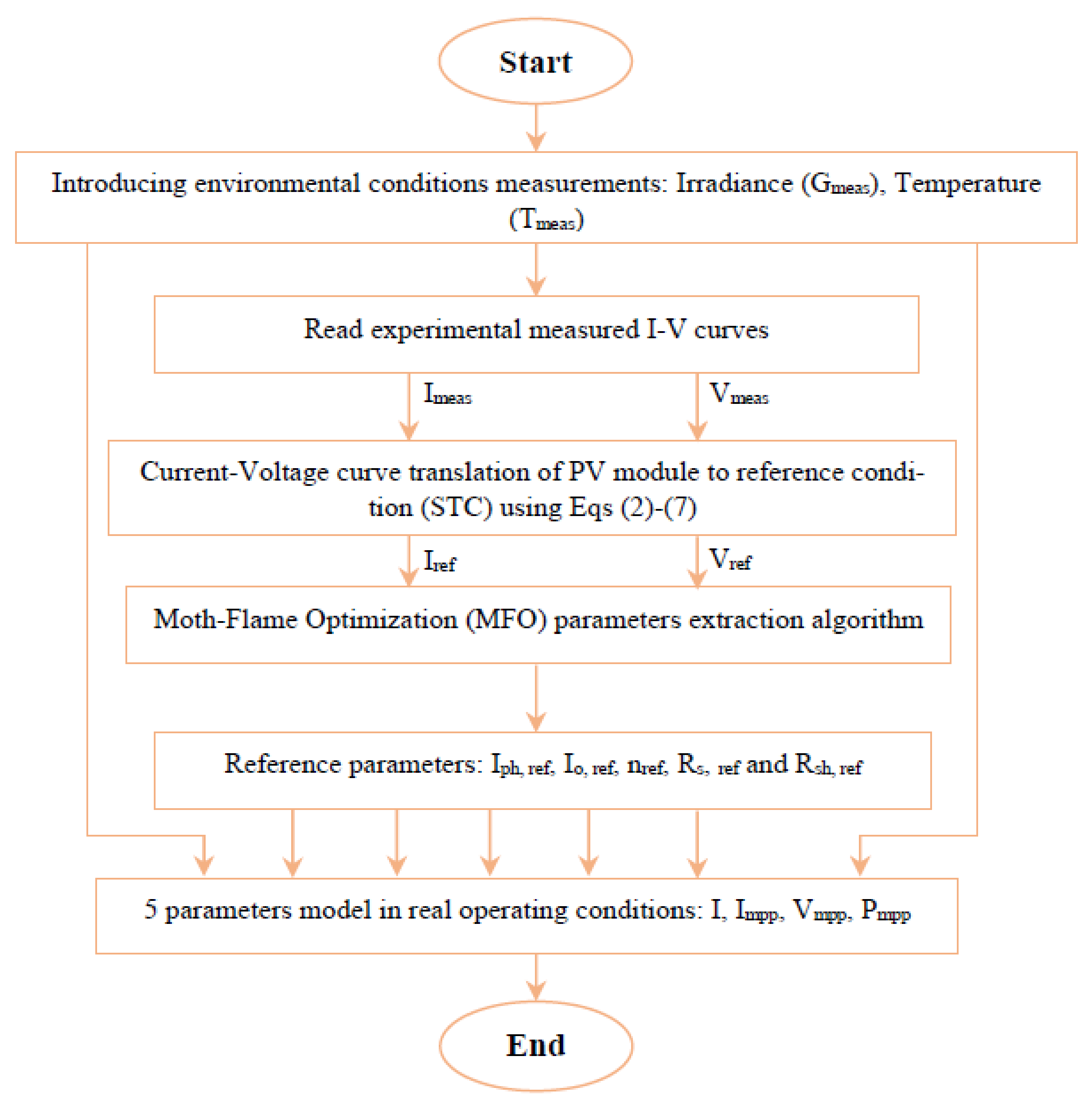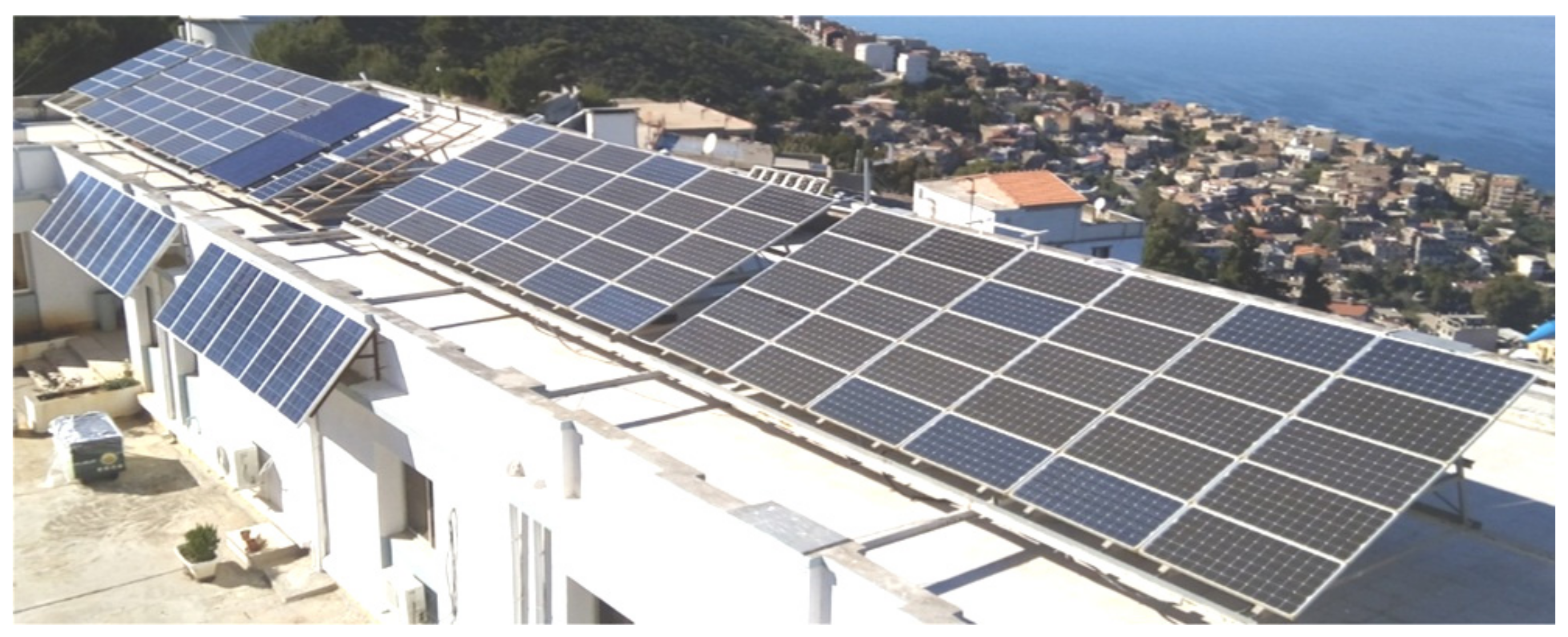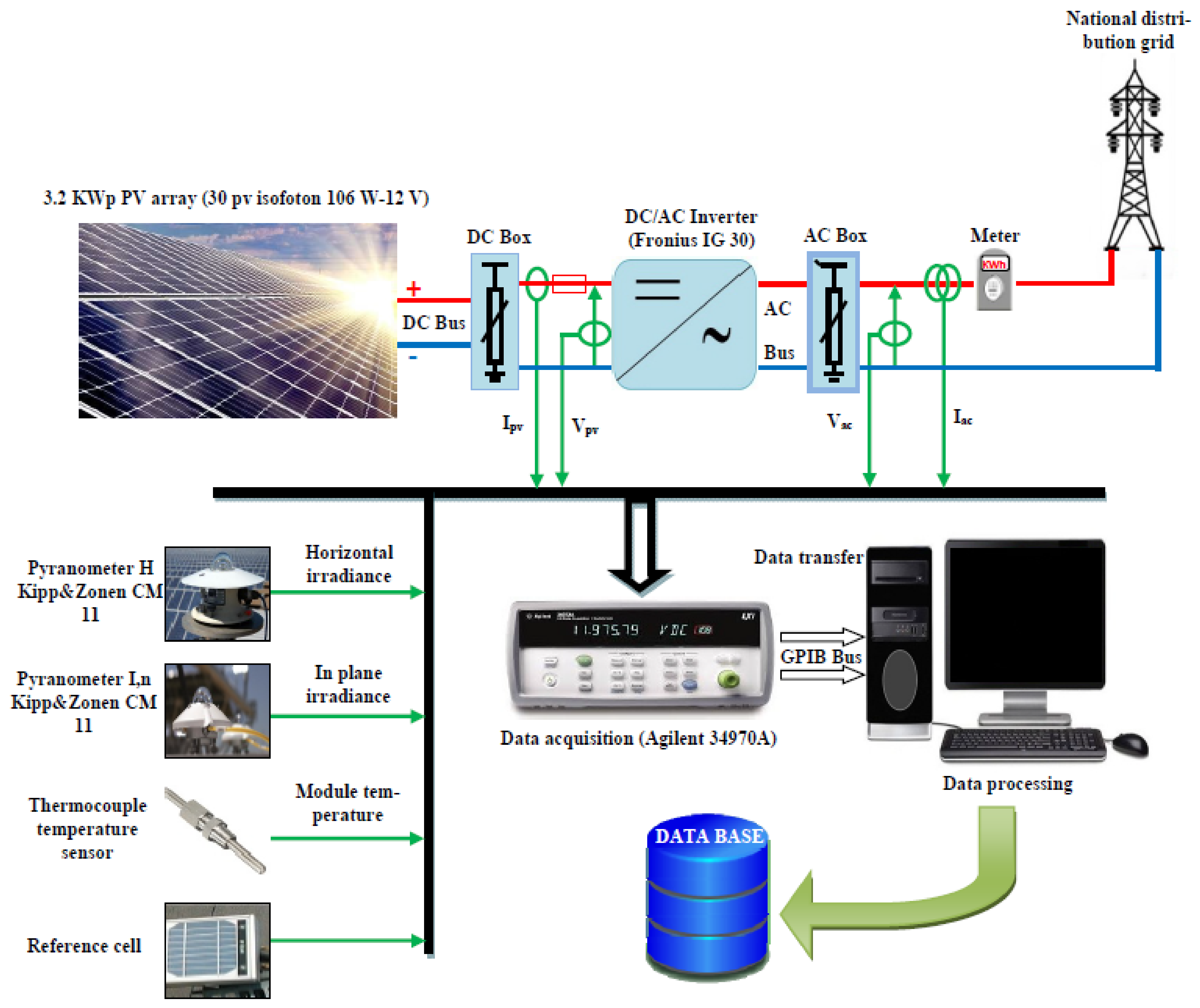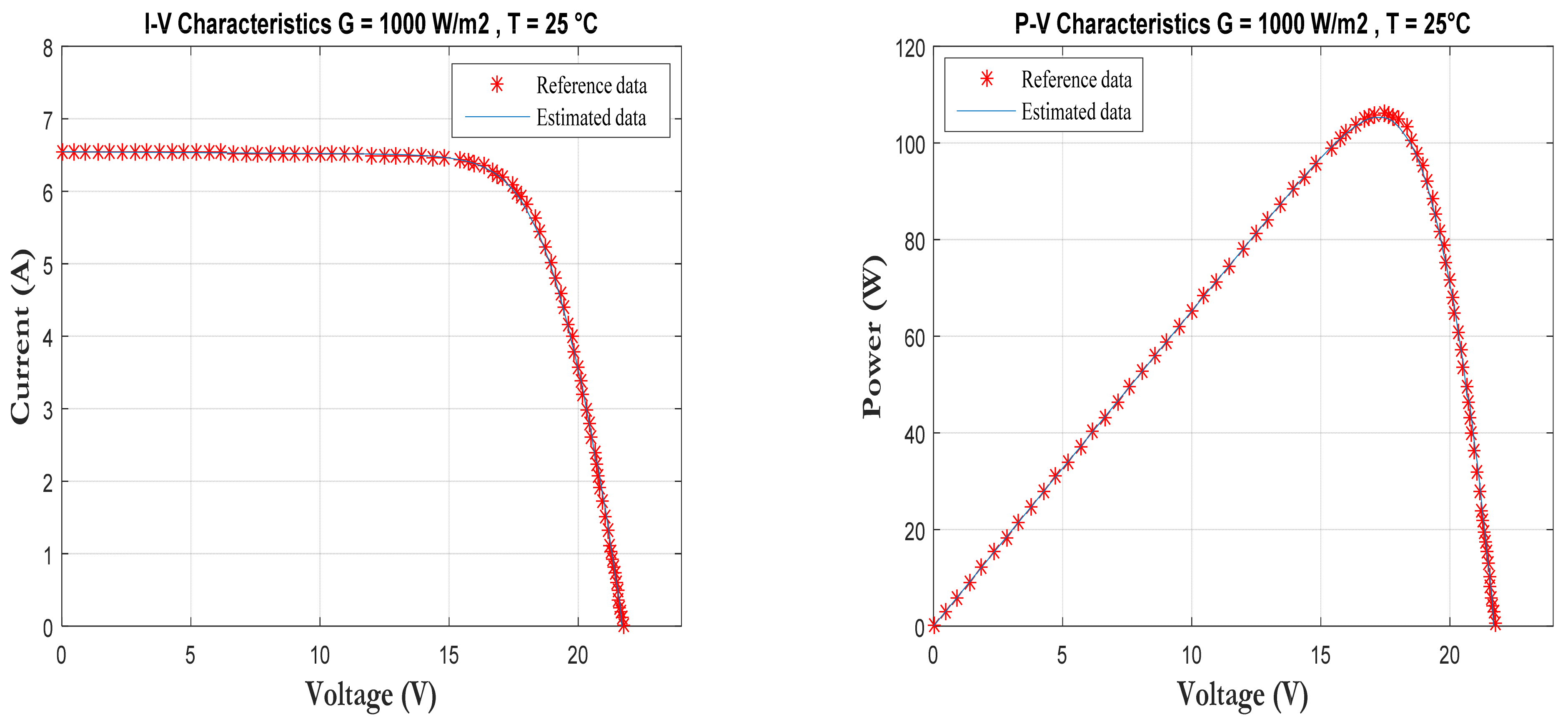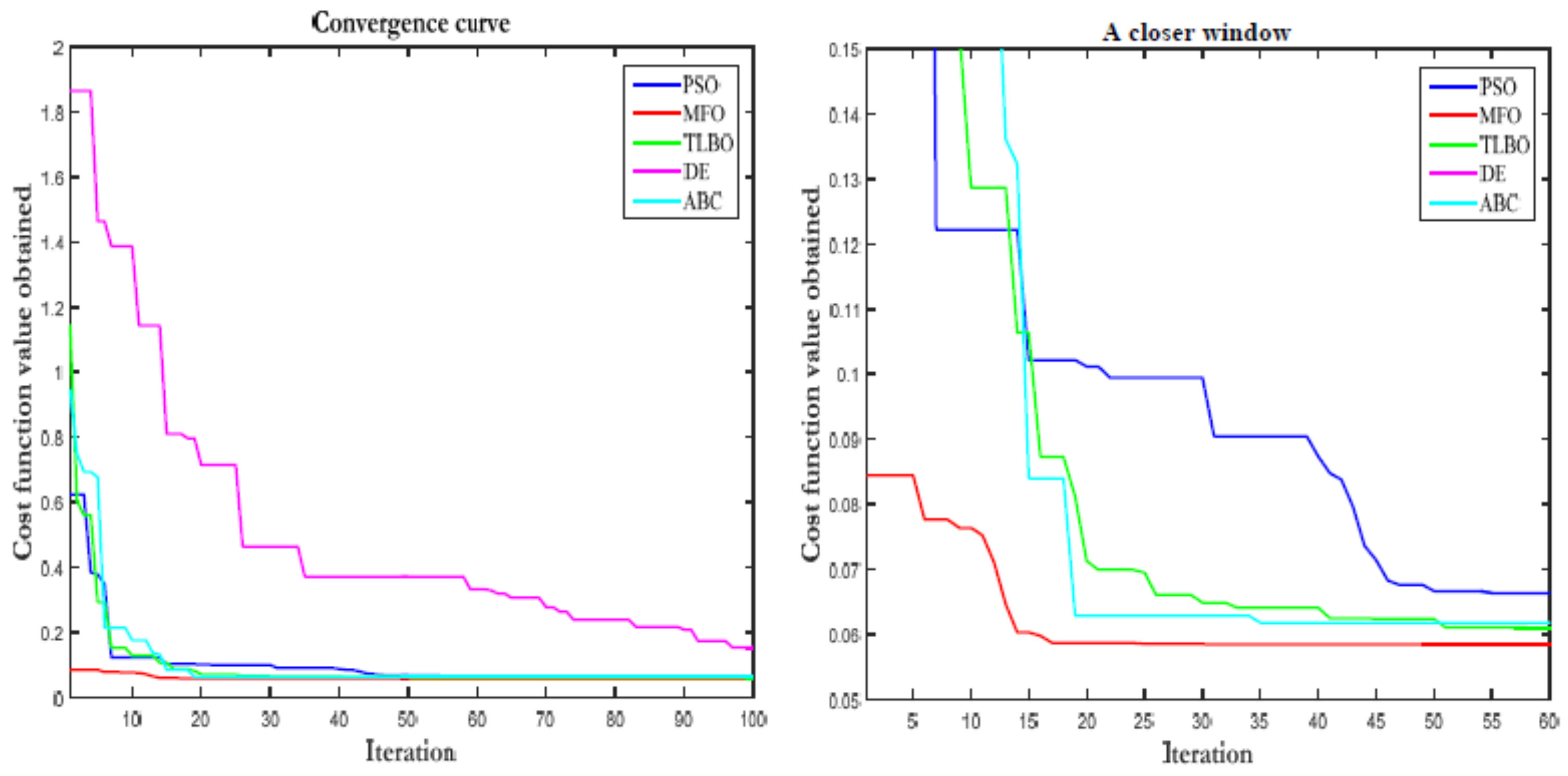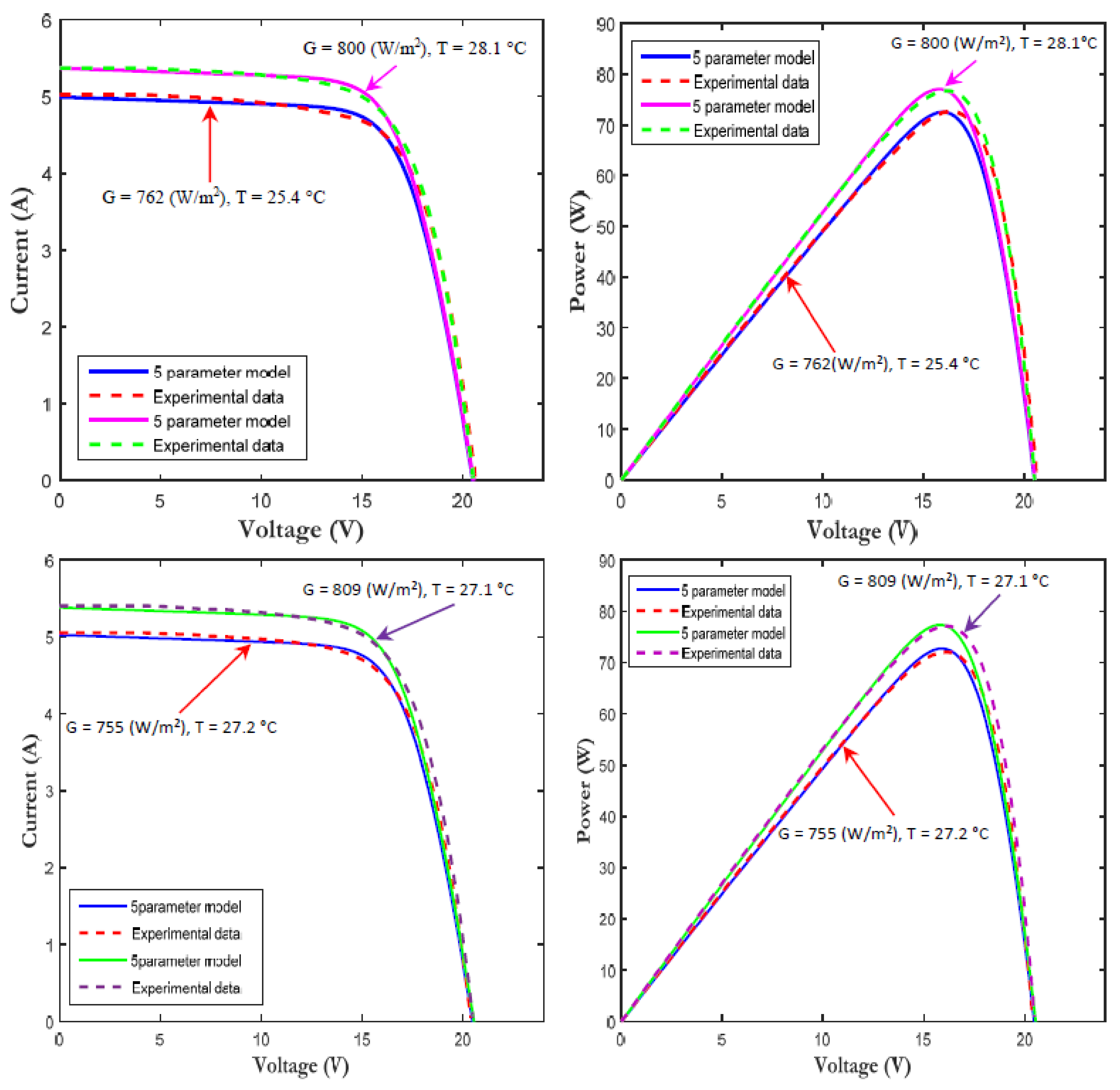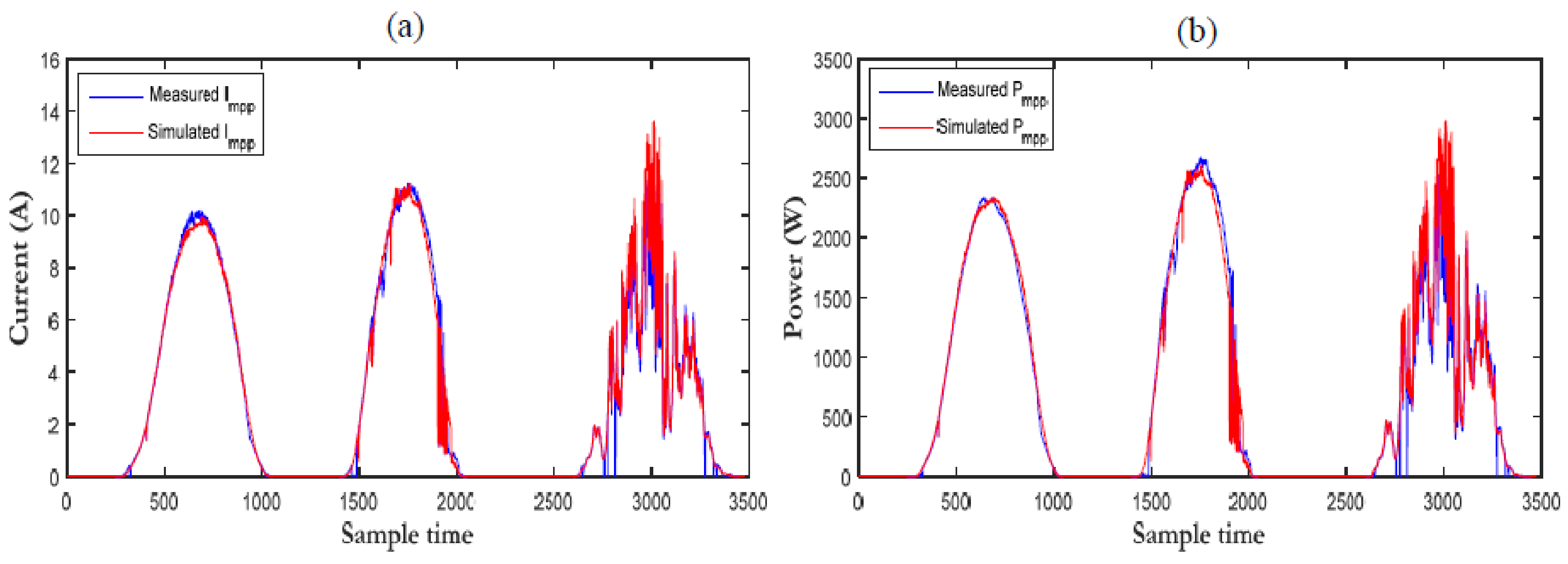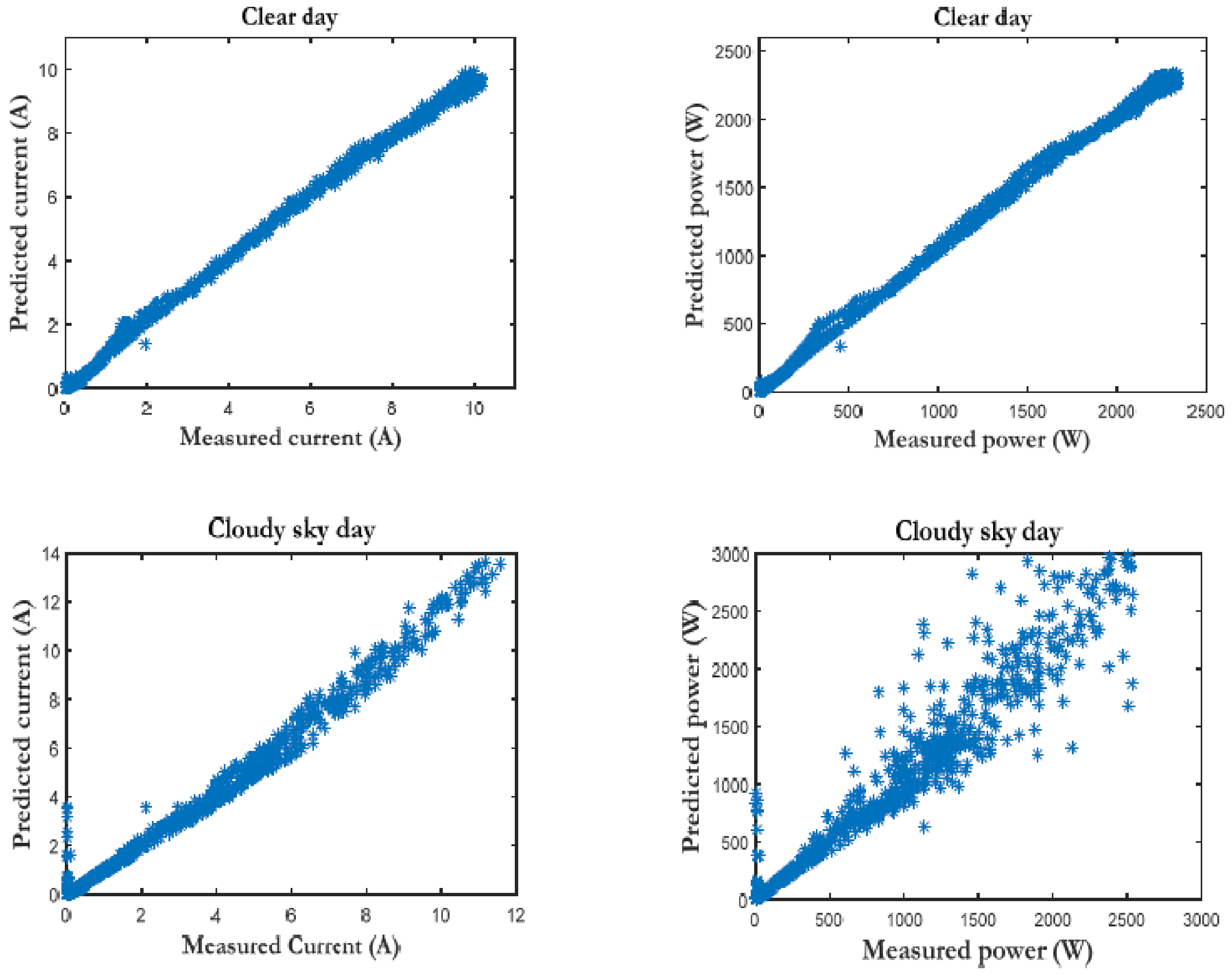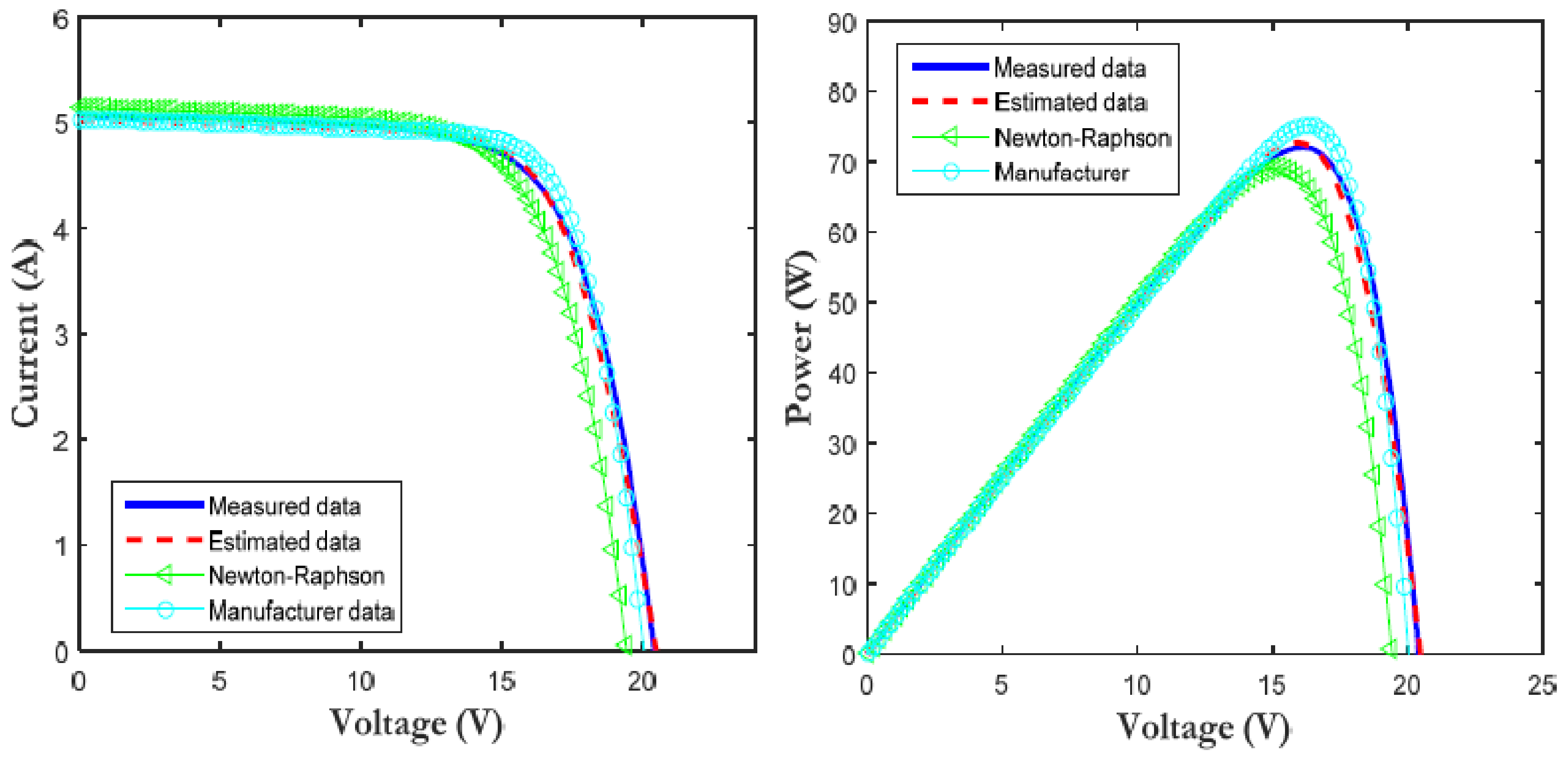1. Introduction
Photovoltaic module is the critical element in a photovoltaic array that is responsible for converting solar energy into usable electrical power. Several studies have reported the electrical modeling of PV modules due to their prime involvement in predicting the overall performance of photovoltaic systems in real working conditions and analyze its efficiency before they are fully employed [
1]. This modeling is also important in many applications, which include the maximum power exploitation [
2], fault detection and diagnosis [
3,
4], module degradation analysis [
5], and power management of an existing PV power plant [
6]. In most related literature, the one diode model has been extensively used due to its simplicity, usefulness and accurate simulation of actual PV plants [
7,
8]. The modeling of the photovoltaic module is closely related to its intrinsic properties and the five parameters which are included in its mathematical model [
9]. From this point of view, it becomes clear the importance of an accurate parameters extraction.
Most of the existing literature that covers PV module parameters extraction explores two main approaches namely analytical and numerical methods. Analytical methods focus on the physical relationship between extrinsic and intrinsic variables while the basic goal of numerical methods is to minimize the quadratic error between measured and estimated variables of interest. For instance, De Soto et al., used an analytical approach based totally on the current-voltage equation analysis at three key points, namely: short circuit point (I
sc), open circuit point (V
oc) and the coordinates of the maximum power point P
m (I
m, V
m). These points are formulated in analytical equations where the five unknown parameters can be extracted using iterative approach [
10]. In other work proposed in [
11], the matching between experimental and theoretical I-V curves is performed by solving the analytic equations, and an iterative variation of R
s and R
p. It is worth mentioning that in many analytical methods, to avoid calculation burden, one of the unknown parameters is fixed and the remainders are found by simultaneous equations solution. For instance, the work proposed in [
12] implements an analytical approach that involves reformulating voltage and current equations in a way that enables them to analytically evaluate the five parameters, relying only on the manufacturers’ datasheets. Compared to the simultaneous solution for nonlinear equations, this approach offers appropriate outcomes. In reference [
13], the authors have used an analytical method, where the electrical circuit parameters are extracted by solving nonlinear equations primarily based on data provided by manufacturers under standard conditions. A simple technique was suggested in reference [
14] in which three parameters are specified: ideality factor, R
s, and R
sh, and it needs four inputs from the manufacturer’s data, specifically: V
oc, I
sc, I
mpp and V
mpp. This method has given good results on crystalline silicon cells. It should be noted that the trend towards simple analytical models by the researcher community that rely primarily on fixing certain parameters or assigning them random values to decrease the calculation burden can be less precise and cause simulation errors.
Numerical methods and optimization algorithms inspired by nature behavior can bypass analytical methods’ complexity and avoid falling into local minima/maxima solutions. Several numerical algorithms, dedicated to the extraction of a single diode model electrical parameters, have been proposed in the literature during the last decade. For instance, in [
15], the proposed approach involves the use of genetic algorithms (GAs) to find the five unknown parameters. In [
16], particle swarm optimization (PSO) is used to extract the PV module electrical parameters, this is done with inverse barrier constraint. To overcome the difficulties in the DE approach, [
17] proposes an improved adaptive differential algorithm (IADE) to extract parameters from a single diode model. Reference [
18] proposed artificial bee swarm optimization (ABSO), while [
19] suggested the artificial bee colony (ABC). In reference [
20], teaching learning-based optimization algorithm (TLBO) was successfully applied to identify parameters for four different types of cells: dye-sensitized solar cells (DSSC), plastic solar cell, and silicon solar cell, as well as silicon solar modules [
21] suggested bird mating optimizer approach (SBMO). The flower pollination algorithm (FPA) was suggested by [
22]. Reference [
23] proposed an improved cuckoo search algorithm (ImCSA). In [
24], the generalized oppositional teaching learning-based optimization (GOTLBO) algorithm is utilized to extract parameters for PV module. [
25] also estimated parameters in the silicon cell, by making extensive use of ant lion optimization (ALO).
It can be noted that the above numerical techniques are primarily based especially on the measured data under different environmental conditions (irradiance, temperature) to extract the parameters. Indeed, most of these parameter extraction algorithms use measured I-V curve data and try to find a unique parameters vector that minimizes the difference between measured and predicted current without taking into account the working conditions including irradiance and temperature. However, most of PV cell parameters are sensitive to weather conditions, so supposing them constant is not quite accurate.
The main motivation of the present paper is to propose an accurate module parameters extraction approach that combines analytical formulation and a numerical optimization method. The suggested approach contains three primary stages. In the first stage, actual I-V curves translation to the reference conditions (i.e., G = 1000 W/m2, T = 25 °C) using analytical formulation. In the second stage, the five unknown parameters in standard conditions are extracted based on the moth flame optimization (MFO) algorithm combining the translated I-V curves with the analytical formula at the reference conditions. The last step consists to find out the I-V couples at actual conditions of temperature and irradiance based on analytical formulas and the reference parameters extracted numerically by the MFO algorithm.
The remaining parts of this paper are summarized in the following points:
Section 2, explains the modeling of the PV array and the proposed parameters extraction approach. The MFO algorithm and five-parameter model are also presented.
Section 3 deals with the presentation of the grid-connected PV system used in this study and provides the experimental results and evaluation of the proposed approach. Finally, this research is concluded in the last section.

